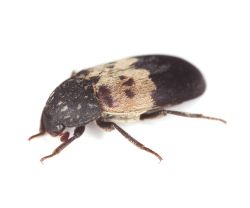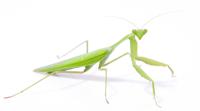 Description:
Description:
The larder beetle gets their name from its tendency to be found in larders, as their name would suggest. The use of refrigeration, the purchase of meats in small quantities, and the lack of home curing of meats, have decreased the economic importance of this insect. However, these beetles are still common in homes, museums, mills, livestock facilities, and any place that contains a suitable food source.
Appearance:
Adult are 1/4""–3/8"" in length black with a whitish band across the fore-part of the elytra. The larva is brownish color and approximately 1/2 inch in length. Migrate to pupate in solid material. Six dark spots are usually in the yellow band. The undersurface of the body and legs are covered with fine yellow hairs.
Lifecycle:
If conditions are ideal, a generation may be completed in 40-60 days at 64-77°F. Through the summer months, females lay more than 100 eggs; the incubation period is less than 12 days. The pupal stage lasts from 3-7 days depending on temperature and moisture conditions. If conditions are ideal, a generation may be completed in 40-60 days.
Habits:
They have also been known to bore into structural timbers. Tests have shown that they can bore into lead with ease and tin with some difficulty. The boring is for the purpose of providing a protected place for pupation, not for feeding. It feeds on various animal products including cheese.






